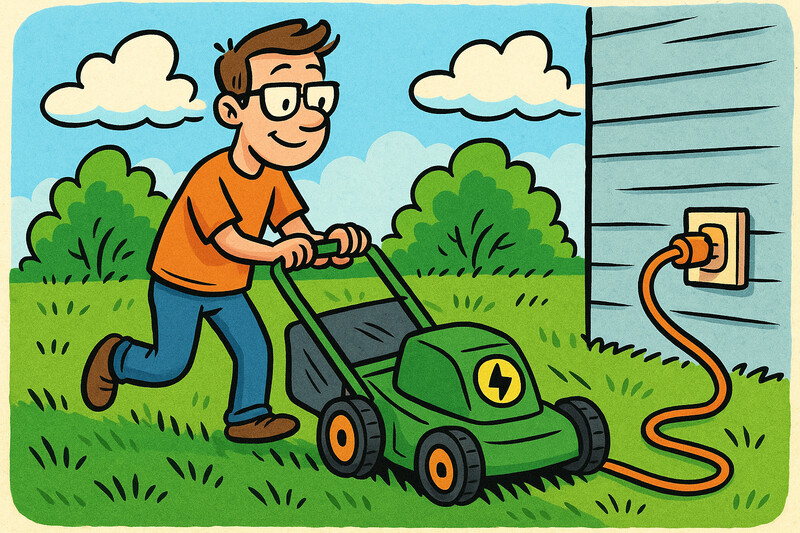Why Electric Lawn Equipment

Many homeowners are discovering the benefits of electric lawn equipment firsthand. Traditional gas-powered tools that once dominated neighborhoods with noise and fumes are being replaced by quieter, cleaner alternatives. This shift isn't driven primarily by environmental concerns, but by the practical advantages electric tools offer for everyday lawn care.
The Noise Factor
Gas-powered mowers typically run at 85-95 decibels. That's roughly equivalent to city traffic or a garbage disposal. Most electric mowers operate around 60-75 decibels, similar to a normal conversation. That 20-decibel difference might not sound like much, but decibels work on a logarithmic scale. A 20-decibel reduction means electric mowers are actually about 10 times quieter.
Noise Level Comparison
Decibel levels with real-world context
| Equipment Type | Decibel Level | Real-World Comparison | Health Impact |
|---|---|---|---|
| Gas Mower | 85-95 dB | City Traffic | Hearing damage risk with prolonged exposure |
| Electric Mower | 60-75 dB | Normal Conversation | Safe noise levels |
The CDC notes that prolonged exposure to sounds above 85 decibels can cause hearing damage, making the quieter operation of electric equipment not just neighborly, but a health consideration.
CDC hearing protection guidelines (opens in new window)For homeowners, this translates to real benefits: you can mow early in the morning or late in the evening without disturbing neighbors, carry on phone conversations while working, and actually hear approaching cars or children playing nearby.
For working parents with limited time, electric mowers offer the flexibility to maintain yards during available hours without disturbing neighbors or feeling guilty about noise levels.
Maintenance
Gas engines require regular oil changes, air filter replacements, spark plug maintenance, and seasonal winterization. Electric motors need none of that. No more trips to the hardware store for small engine parts, no more wondering if last year's gas has gone bad, no more pull-cord frustrations on cold mornings.
The maintenance difference becomes stark when you calculate costs over time. A typical gas mower requires $50-100 annually in maintenance supplies and services. Electric mowers need occasional blade sharpening and that's it. Over a 10-year period, you're looking at $500-1000 savings, often enough to offset the initial purchase price difference.
10-Year Maintenance Cost Comparison
Annual maintenance requirements and costs
| Equipment Type | Annual Cost | 10-Year Total | Maintenance Requirements |
|---|---|---|---|
| Gas Mower | $75/year | $750 | Oil changes ($25), Air filter ($10), Spark plug ($8), Fuel stabilizer ($12), Professional tune-up ($50), Blade sharpening ($15) |
| Electric Mower | $15/year | $150 | Blade sharpening ($15), Battery replacement every 3-5 years ($50-150), Basic cleaning and bolt tightening |
Air Quality: The Invisible Problem
Running a gas-powered leaf blower for one hour produces the same emissions as driving a car 1,100 miles. Gas mowers aren't much better. For homeowners with asthma, allergies, or young children, the air quality impact is a weekly concern.
Equipment Emissions Comparison
Equivalent car driving distance for 1 hour of operation
| Equipment Type | Car Driving Equivalent | Emissions Impact |
|---|---|---|
| Electric Mower | 0 miles | Zero emissions |
| Gas Mower | 800 miles | Significant air pollution contribution |
| Gas Leaf Blower | 1,100 miles | Highest emission rate per hour |
According to the Environmental Protection Agency, small gas engines like those in lawn equipment are significant contributors to air pollution, producing up to 5% of the nation's air pollution and up to 10% during summer months.
EPA mobile source pollution health effects information (opens in new window)Medical professionals in areas with high lawn equipment usage have observed correlations between gas-powered equipment operations and respiratory issues, particularly in children. Gas-powered equipment creates concentrated emissions in residential areas where children frequently play outdoors.
The Technology Has Caught Up
Ten years ago, electric mowers were underpowered novelties suitable only for small, perfectly manicured lawns. Today's electric equipment challenges that perception. Modern battery systems deliver consistent power throughout the charge cycle, and advances in motor efficiency mean many electric mowers can handle tough conditions that would have overwhelmed earlier models.
Landscaping professionals who have transitioned to electric equipment report initial skepticism that transforms into appreciation for unexpected advantages - instant starts, consistent power delivery, and equipment that crews find easier to handle throughout long work days.
The Economics Are Shifting
While electric equipment often carries a higher upfront cost, the total cost of ownership tells a different story. Beyond maintenance savings, electricity costs significantly less than gasoline for equivalent energy. At current prices, "filling up" an electric mower battery costs about 30 cents compared to $3-5 for gas mower fuel.
Per-Use Operating Cost Comparison
Energy cost for typical mowing session (0.5 acres)
| Equipment Type | Cost Per Session | Annual Cost (26 weeks) | Cost Multiple |
|---|---|---|---|
| Electric Mower | $0.30 | $7.80/year | 1× (baseline) |
| Gas Mower | $4.00 | $104/year | 13× more expensive |
Many utility companies now offer rebates for electric lawn equipment, and some municipalities provide additional incentives. When factoring in these programs plus maintenance savings, many homeowners find electric equipment pays for itself within 3-5 years.
Real-World Considerations
Electric isn't perfect for everyone. Large properties (over 1-2 acres) may require multiple batteries or strategic charging breaks. Cold weather reduces battery performance, though less than most people expect. Some high-demand tasks like mulching thick fall leaves still favor gas equipment.
But for the majority of homeowners—those with typical suburban lots who mow weekly during growing season—modern electric equipment delivers everything gas equipment does, with fewer headaches and ongoing costs.
The Bottom Line
The shift to electric lawn equipment isn't driven by environmental guilt or government mandates. It's happening because electric tools solve practical problems that homeowners face every weekend. Quieter operation, minimal maintenance, better air quality, and long-term cost savings create a compelling package that's hard to ignore.
The satisfaction of maintaining a pristine yard with efficient, quiet tools makes the entire lawn care experience more enjoyable.